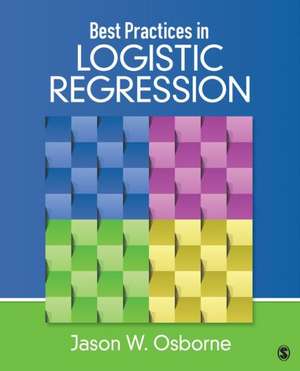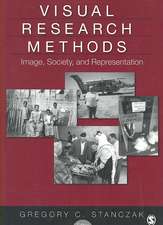Best Practices in Logistic Regression
Autor Jason W. Osborneen Limba Engleză Paperback – 23 apr 2014
Preț: 566.72 lei
Preț vechi: 666.73 lei
-15% Nou
Puncte Express: 850
Preț estimativ în valută:
108.45€ • 115.96$ • 90.42£
108.45€ • 115.96$ • 90.42£
Carte tipărită la comandă
Livrare economică 17 aprilie-01 mai
Preluare comenzi: 021 569.72.76
Specificații
ISBN-13: 9781452244792
ISBN-10: 1452244790
Pagini: 488
Ilustrații: illustrations
Dimensiuni: 187 x 232 x 18 mm
Greutate: 0.72 kg
Ediția:New.
Editura: SAGE Publications
Colecția Sage Publications, Inc
Locul publicării:Thousand Oaks, United States
ISBN-10: 1452244790
Pagini: 488
Ilustrații: illustrations
Dimensiuni: 187 x 232 x 18 mm
Greutate: 0.72 kg
Ediția:New.
Editura: SAGE Publications
Colecția Sage Publications, Inc
Locul publicării:Thousand Oaks, United States
Recenzii
“This text is extremely student-friendly . . . it is a nearly perfect balance of conceptual explanation and application using example data sets”
“This is an absolutely stellar approach to a very difficult and under-used analysis. The use of humor, practical examples, the use of real data, and the inclusion of both basic and advanced concepts without being overly concerned with the derivation of the analysis, foster a better understanding of logistic regression.”
“The text will serve well to widely expand the usage of the logistic regression in social science research. The not-too-technical explanation of core concepts, with numerous computer outputs for illustrations, makes it a perfect text for the senior undergraduate and graduate-level course, as well as a reference for the analytical practitioner.”
“I appreciate the emphasis on application and the coverage of topics that are useful in research but neglected by other books on this method.”
“This is a very impressive book. The topic is timely.”
“It is a very good text and covers topics, such as the need to clean data, inefficiency/volatility of estimates, and missing data effects, that are not generally dealt with.”
“The book includes detailed explanations of various logistic regression models using a range of data and analysis results. It is very suitable for social science students.”
“This book is concise, accessible, and reader-friendly, particularly for those in education research. The value of this book lies not only in laying out certain “best practices,” but more importantly in pointing out common pitfalls and showing newcomers the way around.”
“This is an absolutely stellar approach to a very difficult and under-used analysis. The use of humor, practical examples, the use of real data, and the inclusion of both basic and advanced concepts without being overly concerned with the derivation of the analysis, foster a better understanding of logistic regression.”
“The text will serve well to widely expand the usage of the logistic regression in social science research. The not-too-technical explanation of core concepts, with numerous computer outputs for illustrations, makes it a perfect text for the senior undergraduate and graduate-level course, as well as a reference for the analytical practitioner.”
“I appreciate the emphasis on application and the coverage of topics that are useful in research but neglected by other books on this method.”
“This is a very impressive book. The topic is timely.”
“It is a very good text and covers topics, such as the need to clean data, inefficiency/volatility of estimates, and missing data effects, that are not generally dealt with.”
“The book includes detailed explanations of various logistic regression models using a range of data and analysis results. It is very suitable for social science students.”
“This book is concise, accessible, and reader-friendly, particularly for those in education research. The value of this book lies not only in laying out certain “best practices,” but more importantly in pointing out common pitfalls and showing newcomers the way around.”
Cuprins
1. A Conceptual Introduction to Bivariate Logistic Regression
2. Under the Hood with Logistic Regression
3. Performing Simple Logistic Regression
4. Conceptual and Practical Introduction to Testing Assumptions and Cleaning Data for Logistic Regression
5. Continuous Variables In Logistic Regression (And Why You Should Not Convert Them To Categorical Variables!)
6. Dealing with Unordered Categorical Predictors in Logistic Regression
7. Curvilinear Effects in Logistic Regression
8. Multiple Predictors in Logistic Regression (Including Interaction Effects)
9. A Brief Overview of Probit Regression
10. Logistic Regression and Replication: A Story Of Sample Size, Volatility, and Why Resampling Cannot Save Biased Samples but Data Cleaning And Independent Replication Can
11. Missing Data, Sample Size, Power, and Generalizability of Logistic Regression Analyses
12. Multinomial and Ordinal Logistic Regression: Modeling Dependent Variables with More Than Two Categories
13. Hierarchical Linear Models with Binary Outcomes: Multilevel Logistic Regression
2. Under the Hood with Logistic Regression
3. Performing Simple Logistic Regression
4. Conceptual and Practical Introduction to Testing Assumptions and Cleaning Data for Logistic Regression
5. Continuous Variables In Logistic Regression (And Why You Should Not Convert Them To Categorical Variables!)
6. Dealing with Unordered Categorical Predictors in Logistic Regression
7. Curvilinear Effects in Logistic Regression
8. Multiple Predictors in Logistic Regression (Including Interaction Effects)
9. A Brief Overview of Probit Regression
10. Logistic Regression and Replication: A Story Of Sample Size, Volatility, and Why Resampling Cannot Save Biased Samples but Data Cleaning And Independent Replication Can
11. Missing Data, Sample Size, Power, and Generalizability of Logistic Regression Analyses
12. Multinomial and Ordinal Logistic Regression: Modeling Dependent Variables with More Than Two Categories
13. Hierarchical Linear Models with Binary Outcomes: Multilevel Logistic Regression
Notă biografică
Descriere
This book explores the fun things researchers can do with logistic regression, explicates and simplifies the confounding complexities of understanding what logistic regression is, and provides evidence-based guidance as to what the best practices in performing logistic regression are.










